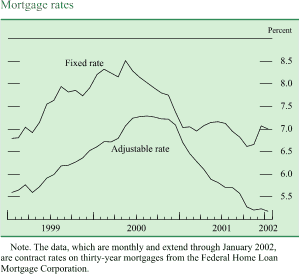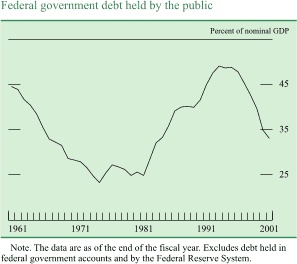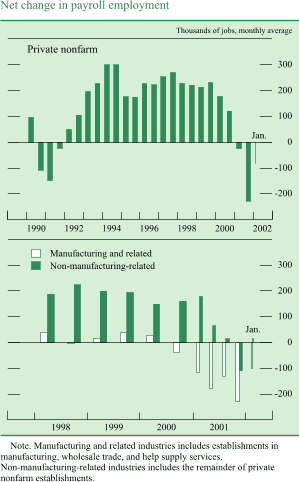Emerging Market Economies
Argentina was a main focus of attention among
emerging market economies in 2001. In the first part of
the year, worse-than-expected data on the fiscal
situation and concerns that the government would be
unable to implement announced fiscal measures
heightened doubts about whether Argentina would be
able to avoid a default on its debt. Argentine financial
markets received only temporary support from a
large-scale debt exchange completed in June and an
enhancement of IMF support approved in September.
With financial market confidence eroding, conditions
took a dramatic turn for the worse late in the year;
financial asset prices fell sharply, and funds moved out
of the banking system as the government moved to
restructure its debt and the one-to-one peg to the dollar
looked increasingly precarious. In early December, the
government imposed capital controls, including limits on
bank account withdrawals. These restrictions led to
widespread protests, which triggered the resignation of
President de la Rua and an interval of political turmoil.
After the resignation of President de la Rua, the
government announced it would suspend debt
payments to the private sector. The government of the
new president, Eduardo Duhalde, suspended
Argentina's currency board arrangement and
established a temporary dual exchange rate system. In
early February, the dual exchange rate system was
abandoned, and the peso's floating rate moved to about
2 pesos per dollar amid continuing economic
uncertainty. For 2001 as a whole, Argentine real GDP
is estimated to have fallen at well over a 5 percent rate,
and prices declined further.

To date, the negative spillover from events in Argentina
to other emerging financial markets has been limited,
possibly because market participants had been well
aware of Argentina's problems for some time and
viewed them as largely confined to that country. Brazil
was probably most heavily affected by events in
Argentina, and the bond spread on Brazilian debt
showed a net increase of about 110 basis points over
the course of last year while the spread on Argentina
debt exploded upward. Other important factors
weighing on Brazilian economic activity last year likely
were weak growth in the United States--Brazil's most
important export market--and the emergence of an
energy shortage as drought limited hydroelectric output.
For the year as a whole, Brazilian real GDP is
estimated to have risen at less than a 1 percent rate
after growing at a 4 percent rate the previous two
years. The Brazilian currency registered a net
depreciation against the dollar of about 16 percent over
the course of last year, while stock prices declined
more than 10 percent. The Brazilian central bank
tightened policy last year in an effort to hold down the
inflationary impact of currency depreciation.
Real GDP in Mexico declined about 1 percent in 2001,
a sharp reversal from the 5 percent growth rates
recorded in the previous two years. The falloff in
activity was mainly a reflection of the negative effects
on direct trade and confidence in Mexico arising from
the slowdown of the U.S. economy. In light of the
marked weakening of activity, declining inflation, and a
strong peso, the Bank of Mexico started to loosen the
stance of monetary policy in May, and short-term
interest rates continued to decline over the rest of the
year. In February 2002, the Bank of Mexico moved to
tighten monetary conditions, citing concerns that an
increase in administered prices would raise inflation.
Mexican financial markets fared quite well last year,
with the peso appreciating 5 percent against the dollar
and stock prices rising nearly 15 percent. The effect on
Mexican financial markets from Argentina's difficulties
appeared to have been quite limited, as indicated by the
net decline of the Mexican debt spread by 80 basis
points over the course of the year.
Economic growth in the Asian emerging market
economies turned negative last year. On average, real
GDP in developing Asia is estimated to have declined
about 1 percent in 2001, compared with average
growth of 6 percent in the previous year. A key factor
in this slowing was the sharp falloff in global demand for
the high-tech products that had fueled rapid export
growth in the region in recent years.
The economies of Taiwan, Singapore, and Malaysia
are highly dependent on exports of semiconductors and
other high-tech products, and as global demand for
these goods was cut back sharply, real GDP in these
countries declined by an estimated 5 percent on
average last year. Indonesia and Thailand, both
relatively less dependent on high-tech exports and
experiencing some reduction in political tension over the
course of the year, managed to record small positive
real GDP growth rates last year, albeit well below rates
of the previous year.
Korean real GDP is estimated to have increased about
2 percent in 2001. While in an absolute sense Korea is
an important exporter of high-tech products such as
semiconductors, it has a relatively more diversified
economy than most of its Asian neighbors, and thus the
magnitude of its slowdown last year was somewhat
muted. Government moves toward monetary and fiscal
policy stimulus over the course of the year helped
support domestic demand in Korea.
In China, recorded growth of real GDP remained
robust last year. China's lesser dependency on exports
in general, and high-tech exports in particular,
cushioned it from last year's global slowdown, and the
government stepped up the pace of fiscal stimulus to
offset weakening private demand. Hong Kong, with
exports not heavily concentrated in high-tech goods
and an economy closely integrated with a rapidly
growing Chinese economy, is nevertheless estimated to
have experienced a decline in real GDP last year. The
peg of Hong Kong's currency to a strengthening U.S.
dollar put pressure on its competitive position, and
domestic price deflation continued.
Conditions in financial markets in emerging Asia were,
for the most part, not particularly volatile last year.
Debt spreads were little changed on average for the
region as a whole, exchange rates against the dollar
generally moved lower, and stock indexes declined
somewhat on average.
|
















































